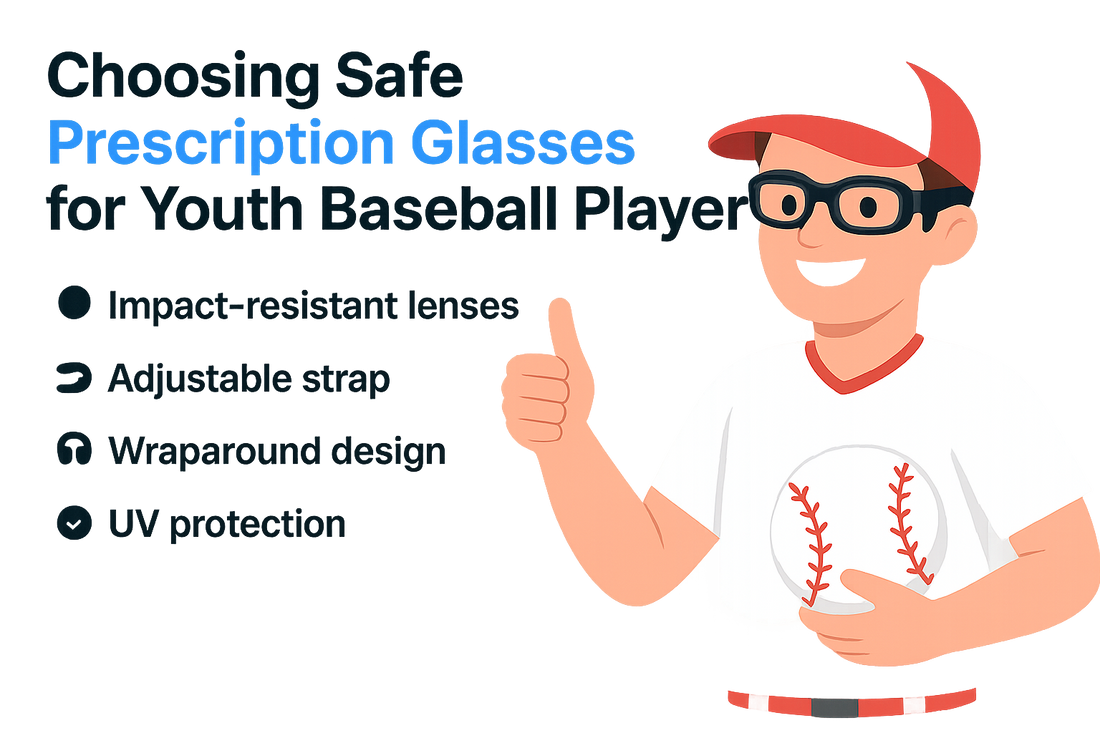
Choosing Safe Prescription Glasses for Youth Baseball Players
Line drives, dust, and bright sun are part of every ballplayer’s world. For kids who need vision correction, the right pair of prescription sports glasses can make the game clearer and safer. Here is a parent-friendly guide to picking eyewear that protects young eyes, stays put during play, and helps your athlete see the ball from the mound to the outfield. ⚾👓
Why eye protection matters in youth baseball
Baseball ranks high for sports-related eye injuries, often caused by fast-moving balls or accidental contact. Everyday fashion frames are not designed to handle impacts. Sports eyewear built for youth adds a sturdy frame, shatter-resistant lenses, and a secure fit so your player can focus on the next pitch, not their glasses.
Frames: durable, protective, and helmet-friendly
- Impact-ready materials: Choose tough, flexible frames that can absorb and disperse force without cracking.
- Wrap or shield design: Slight curvature helps protect the sides of the eyes and keeps dust out.
- Padding and edges: Soft nose bridges and temple cushioning add comfort and reduce pressure points.
- Retainer strap: A detachable or integrated strap helps glasses stay secure on slides, sprints, and steals.
- Ventilation: Small vents around the lenses or frame promote airflow to reduce fogging inside a batting helmet.
- Helmet compatibility: Test with your child’s batting helmet to confirm the temples, strap, and frame profile fit smoothly.
Lenses: clarity and protection where it counts
- Polycarbonate or Trivex: Both are lightweight, highly impact-resistant, and ideal for kids’ sports prescriptions.
- UV protection: Ensure lenses block 100% of UVA and UVB for outdoor practices and games.
- Scratch resistance: A hard coat helps lenses last longer in dusty, gritty dugouts.
- Anti-fog: Useful for humid days and high-exertion innings, especially under helmets.
- Tints and photochromic: Amber or brown tints enhance contrast against the sky or grass. Photochromic lenses that darken outdoors are convenient for changing light. 🛡️
Prescription considerations for young players
Most kids play best with single-vision lenses that provide a wide, undistorted field. If your child has a higher prescription, ask about lens thinning options that maintain impact resistance without adding too much weight. For astigmatism, precise centration is essential to keep the ball crisp at bat and in the field.
Fit and comfort: the secret to keeping glasses on
- Three-point fit: Check the bridge, temples, and strap contact. No pinching, slipping, or gaps.
- Nose bridge size: Kids often need narrower bridges or adjustable pads to stay centered during running.
- Temple grip: Rubberized tips and light frame weight help reduce bounce on quick moves.
- Vision alignment: Pupillary distance must be spot on so the optical center lines up with where your child looks through the lens.
Care and maintenance tips
- Rinse lenses with clean water before wiping to remove infield dust.
- Use a microfiber cloth and lens-safe spray to avoid scratches.
- Air dry the strap and pads after sweaty practices to keep them fresh.
- Store in a hard case between games to prevent damage in gear bags.
Quick sideline checklist ✅
- Glasses feel stable with head turns and quick sprints.
- No hot spots on the nose or behind the ears after 15 minutes.
- Clear, distortion-free vision across the lens area your child actually uses.
- Helmet slides on and off without knocking the glasses out of position.
- Strap stays snug, lenses stay fog-free, and UV protection is confirmed.
Common mistakes to avoid
- Choosing fashion frames instead of impact-resistant sports eyewear.
- Skipping the strap, then battling slips during the first inning.
- Overlooking anti-fog for humid climates or heavy sweaters.
- Ignoring helmet fit until game day.
FAQs
How do I know if my child’s sports glasses are impact-resistant?
Look for lenses made from polycarbonate or Trivex and frames designed for sports use with sturdy construction and a secure strap.
What lens tint works best for baseball?
Amber or brown tints enhance contrast against grass and the sky, helping track the ball in variable light.
Can prescription sports glasses fit under a batting helmet?
Yes. Choose a low-profile frame with good ventilation and test helmet compatibility to ensure nothing shifts.
Do kids need anti-fog coatings?
Often, especially in humid weather or when wearing helmets. Anti-fog helps keep vision clear during intense play. 😅
Why pick a strap over standard temples?
A strap keeps glasses secure during sprints and slides, reducing distractions and the risk of drops.



